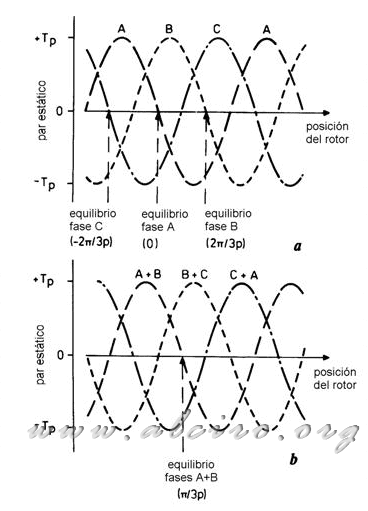2.1.3. Excitation sequences
The phase windings of the stepper motors are electrically isolated, and each has its corresponding circuit. The power stage can be performed individually, together or alternating the two. Depending on the excitation sequence and the type of engine, we get the static torque characteristics.
2.1.3.1. Variable reluctance motors
Sinusoidal approximation to the torque characteristics shown in Figure 3.4 (a) relating to a variable reluctance motor of three phases with one phase excited.
The displacement between the characteristics of each phase corresponds to the length of a step, for example, if we start from the position of equilibrium with phase A excited, we have the length of a step when the excitation is passed to phase B, If rotor is initialized at the equilibrium position of phase A, when the excitation is changed to phase B of the rotor experiences a positive torque that moves the equilibrium position of phase B. In the same way if the excitation is switched from phase A to C the torque is negative, moving the rotor in the opposite direction toward the equilibrium position of phase C. When a phase is switched to OFF and the other is excited (ON), it fails to consider the characteristic of torque off the stage and applies the property of the active phase for the position you are in the rotor at the time of switching.
The effect of exciting two phases at the same time is illustrated in Figure 3.4 (b). This shows the static torque characteristics depending on the position for phases AB, BC and AC excited. Obtained with the sum of the pair that gives each of the phases corresponding to the sequence of activation of a single phase. Comparing figures 3.4 (a) and 3.4 (b) shows that the characteristic curves with the excitation of two phases is displaced, and the peak static torque is the same value. The analytical result obtained from the static torque characteristics for a three-phase VR motor with one phase is excited:
 \\ T_B\ =\ -T_p*sin(d*\theta - \frac{2*\pi }{3})\\ T_C\ =\ -T_p*sin(d*\theta - \frac{4*\pi }{4})) (3.4)
(3.4)

Figure 3.5. Caracteisticas of static torque curve for a variable reluctance motor and a three-phase stator. (A) sequencer excitation of an active phase. (B) Sequence of excitation of two active phases.
for a sequence of excitation of two active phases of the pair is the sum obtained in the sequence of an active phase.
 \\ T_{BC}\ =\ T_B+T_C\ =\ -T_p*sin(d*\theta - \pi)\\ T_{CA}\ =\ T_C+T_A\ =\ -T_p*sin(d*\theta - \frac{5*\pi }{3})) (3.5)
(3.5)
The graphs and analytical results indicate a difference in the equilibrium position for the two sequences of excitement, with two active phases, the equilibrium position is between the equilibrium positions corresponding to the sequence of an active phase. Physically, the rotor poles are not aligned with the stator poles, they are subject to attractive forces that generate the two active phases being the equilibrium position between two teeth.
Another variant of alternating sequences of operation in the engine of an active phase and two active phases, A, AB, B, BC, C, CA, A, ... . This type of excitation produces an incremental movement of ½ of the total length of the step. This sequence is known as a media operation steps (half stepping).







